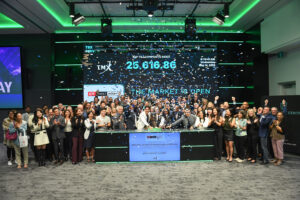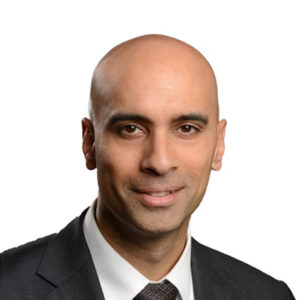
On Wednesday, BMO ETFs conducted its second annual ETF Investor day. Conducted at the Toronto Stock Exchange, Do-it-yourself investors and finfluencers [Financial Influencers] were on hand for the ceremonial opening of the exchange, shown in the photo on the left (including myself).
Hard to believe, but this marks BMO’s 16th year as a Canadian ETF provider.
Before we get to the individual expert picks from BMO’s large ETF stable, the morning began with the obligatory analysis of the current Trump-inspired global trade war, and its implications for the Canadian economy and stock market.
Economic Update
In an Economic update Amber Kanwar, Host of the In the Money Podcast interviewed Bipan Rai, Head of ETF & Structured Solutions Strategy at BMO ETFs. Rai said the protectionist measures being imposed by the Trump administration have “not been seen since the Great Depression.” In the U.S. tariffs are now north of 20%, or ten times the 2% average tariffs that were previously in place.
Asked what will happen next, Rai said probably one of three things: Trump might rescind the Tariffs, or there will be a massive expansion of U.S. fiscal policy to fund its Tax Cuts, or the Federal Reserve will cut rates. But he doesn’t think a U.S. recession will show up this year, as its economy is “too dynamic.”

However, Rai was less confident that Canada won’t face a Recession: “I’m very concerned about the Canadian economy in coming quarters.” The two most recent scenarios from the Bank of Canada are mixed: one is “far more benign,” the second “more malignant.” He thinks the former is more likely, with a few negative quarters of GDP growth but not likely exhibiting Stagflation risk. 70% of Canada’s GDP is generated from trade, “most of it with the U.S. As much as [Prime Minister Mark] Carney talks about diversifying away from the U.S., that’s not going to happen. The U.S. is way too big and is right next door. We may do more with the United Kingdom but it and the European Union won’t replace the U.S. Jobs may be lost, especially in the auto sector.”
Asked if he expects more rate cuts from central banks around the world, Rai said he thinks the BOC is likely closer to the end, with one or two more rate cuts, after which fiscal stimulus will kick in. England or the ECB may cut a few more times, then Japan and a few “others divorced from the rest.”
How retail investors can play Defence
Kanwar also probed the views of two experts in a session titled Playing Defense: Positioning Your Portfolio in today’s environment. Now that the U.S. market has rebounded 18% from the lows around early April’s Liberation Day, Kanwar asked how Do-it-yourself [DIY] investors can deal with volatility. Jimmy Xu, Head of Liquid Alternatives & Non-linear solutions, BMO ETFs, said it depends on investor goals. Those with a long-term 20- or 30-year time horizon before Retirement would be “best to sit tight,” Xu said, “Overtrading is the enemy of growing assets and market timing is hard.”
Freelance writer Tony Dong, founder of ETF Portfolio Blueprint, said volatility is the price of admission to create investment returns that are superior to risk-free treasury bills. Betting on certain sectors may expose DIY investors to uncompensated risk, Dong said. Even equal-weight products provide imperfect exposure to the size premium commanded by small- and mid-cap stocks. But investors can overweight less volatile stocks concentrated in structurally defensive sectors like health care, utilities and consumer staples. Jimmy Xu said sector-agnostic low-volatility strategies can help investors get around this problem. BMO’s low-volatility ETFs own low-volatility stocks that have a low beta relative to the broad market, which amounts to “a better tool than picking top sectors.”
Dong said investors can use low-volatility products as part of the Satellite part of portfolios (as opposed to the central Core) perhaps to the tune of 10 or 20% of the total portfolio. “But it’s important to rebalance and systematically buy low and sell high.”
DIY Investing: Smart Strategies & Community Insights
Another panel featured two finfluencers: Braden Dennis, Founder of the Canadian Investor Podcast and Max Nicholson, CEO and co-founder of Blossom Social Investing. Zayla Saunders, BMO ETFs’ Senior Associate, Online Distribution asked about the trend of investors chasing ETFs sporting the highest yields. Braden cited the danger posed to investors even a year ago by the excessively high yield of BCE stock, which subsequently lost 60% of its capital and just last week cut its dividend in half, as Braden had warned it would. Even so, Nicolson defended dividends, describing them as being “good motivation for beginning investors.” ETFs play a “massive role” in building financial literacy for DIY investors, he said: 60% of Blossom’s assets are in ETFs.
Saunders said the most popular themes BMO sees are index ETFs and Asset Allocation ETFs, with a shift recently away from focusing too much on the U.S. stock market. Investors are looking for more geographic diversification through all-in-one ETFs like BMO’s ZEQT, although some pick more specialized regions like India, played through its ZID ETF.
Braden said that when people are bearish on the U.S., “it’s a good time to buy U.S. stocks. There’s no better ecosystem for capital than the U.S. Yes, geographic diversification is important but many constituents in the U.S. are global businesses,” such as the Magnificent 7 tech stocks.
ETFs to add to your Watchlist
The final session invited “thought leaders” Larry Berman, Tony Dong, Bipan Rai and Valerie Grimba to make the case for their personal favourite BMO ETFs. Valerie Grimba, director of institutional ETFS for market maker RBC Capital Markets, cited ZAAA: BMO AAA CLO ETF, which she said helped democratize an asset class previously hard to access at the Advisor or DIY level. CLOs are Collateralized Loan Obligations, which have been around 30 years but there’s never been a default at the AAA level. ZAAA provides a “nice pickup over floating rate.” CLO pays above the overnight rate and resets quarterly so has low to zero duration risk in a period of volatility, she added. It helps diversify a Fixed Income portfolio since it has a low correlation to other Fixed Income products.
Tony Dong’s pick was ZGI: BMO Global Infrastructure Index ETF, which is an asset class that he said are used by most institutional pension managers. Real assets like airports are otherwise hard to access by retail investors.
While both ZAAA and ZGI are two of his top picks, Bipan Rai also likes ZXCQ: BMO Target 2029 Canadian Corporate Bond ETF. He says investors need to consider what happens in the final year (2029) when the fund shuts down and if rates fall that last year. BMO solved this dilemma by locking in the Internal Rate of Return of 3.5%. If yields turn out to be higher in the last year, investors can liquidate the fund in advance and reinvest the proceeds. In short, ZXCQ is flexible and provide a locked-in IRR floor.
To this, session moderator Erin Allen — who is Vice President, Direct Distribution, BMO ETFs — reminded the audience that BMO is the number 1 provider of Fixed Income ETFs in Canada: “We waited for rivals to come out, saw the pain points and launched a superior product.”
ETF Capital Management’s Larry Berman, host of BNN’s Berman’s Call, picked a structured outcome ETF: ZAPR: BMO US Equity Buffer Hedged to CAD/April. Buffer ETFs seek to protect from market downturns: full explanation here. While mainstream asset allocation ETFs like ZBAL or ZCON are appropriate for most investors, Berman said he is concerned about inflation and he considers bonds to have been “broken structurally for a long time.” ZAPR has a risk profile like a balanced ETF but provides 100% exposure to the best market benchmark: the S&P500, Berman said. “After a correction, you want all the upside: you don’t need to go to cash; you get the protection you need that bonds won’t give you anymore, except ZAAA.”
Based on audience applause, Berman’s pick won him a bottle of wine.

